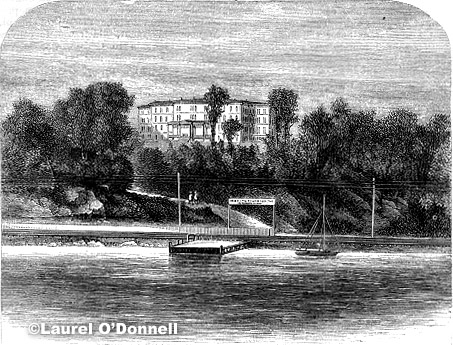|
|
Ten Days With the Deaf and DumbBy Mary Barrett
 Above: New York Institution
For The Instruction Of The Deaf And Dumb On the eastern bank of the Hudson, in that part of Manhattan known as Washington Heights, stands the New York Institution for the Instruction of the Deaf and Dumb. This school, now in its fifty-fourth year, has grown to be the largest and probably the most complete establishment of its kind in the world. Leaving the city by way train on the Hudson River Railroad from Thirtieth Street, we stop at the station in One Hundred and Fifty-second Street, which is also called Carmansville. A pleasant drive of half a mile brings us to the eastern entrance of the grounds. It is now some nineteen years since the school was removed from its former location in Fiftieth Street to this spot. With prudent forethought, ample grounds were then secured at a comparatively small expense, thirty-seven and a half acres having been purchased for not much over one hundred thousand dollars. Since that time the value of real estate in the upper part of the island has advanced so much that nine and a half acres of this land were sold in May, 1870, for two hundred and sixty-three thousand dollars. The sum thus realized frees the institution from debt, and enables it to make certain long-desired improvements. As we drive along the pleasant winding avenue after entering the grounds, we soon discover through the trees some of the buildings of the establishment. Passing the mansion of Dr. Harvey L. Peet, the late venerated principal emeritus — the home also of his son, the present principal — we come in sight of the workshops, standing apart in the rear of the main building, and also of the school-house, which is joined to it by covered corridors. Here we observe groups of the children playing merrily about the doors, some jumping rope, and some busy with various other sports. And now, having passed the south wing and turned northward, we pause in front of the main edifice. We must delay a moment before entering to notice the magnificent view. The beautiful Hudson, here a mile and a half wide, is, of course, the first and the finest thing we see. We are just opposite the southern extremity of the Palisades, whose rugged outlines and wood-crowned summit are perfectly reflected in the still blue water below. White sails dot the surface of the broad tranquil river, while here and there the trailing smoke and the shining wake of some steamer catch the eye. Yet the river lies far below us; it is not less than one hundred and twenty feet perpendicularly from the spot where we stand to the water's edge. Even the track of the railway, which runs Page 1
These pages are © Laurel O’Donnell, 2006, all rights reserved Copying these pages without written permission for the purpose of republishing in print or electronic format is strictly forbidden. Books & articles appearing here are modified adaptations. This page was last updated on 01 Jul 2006 |
